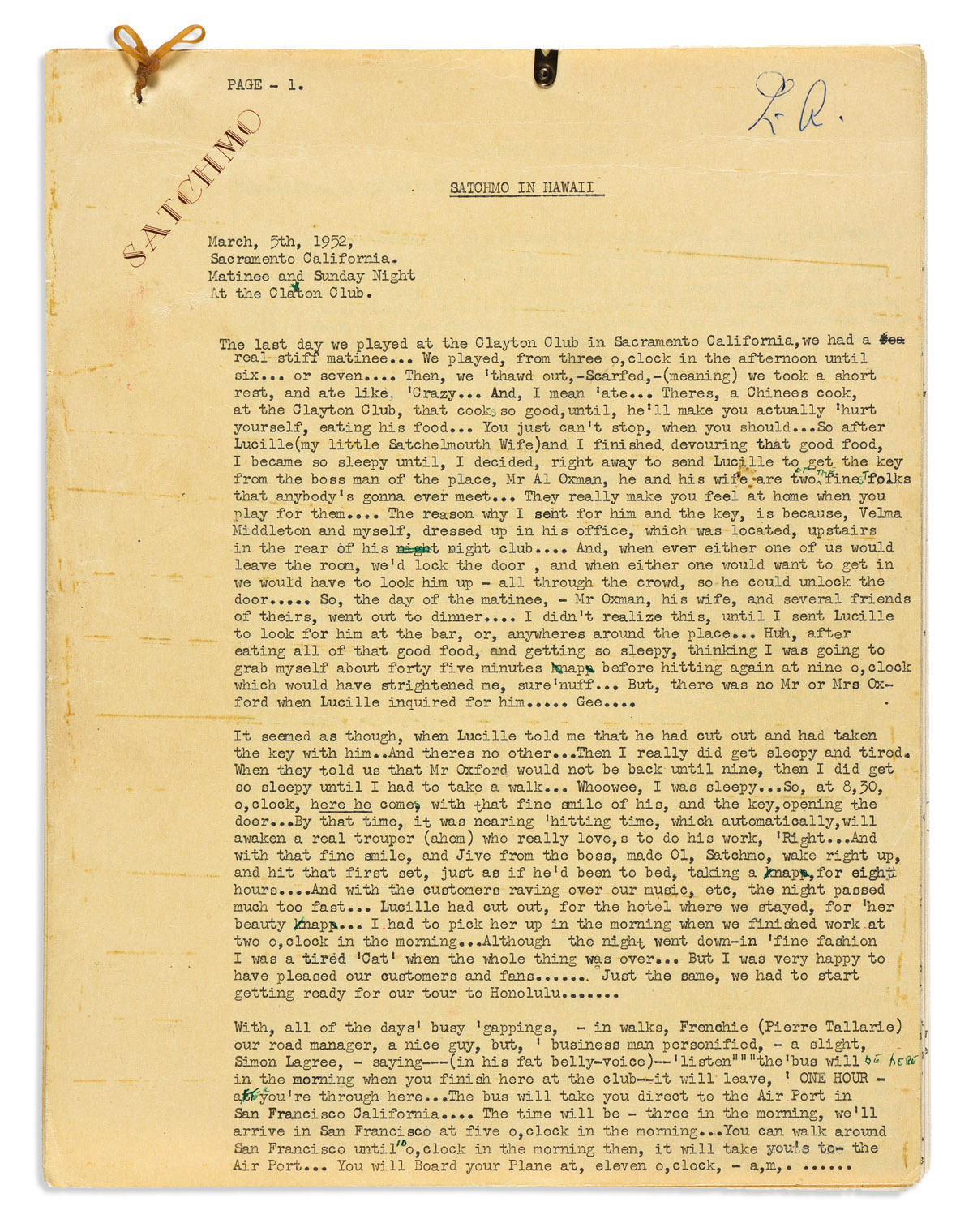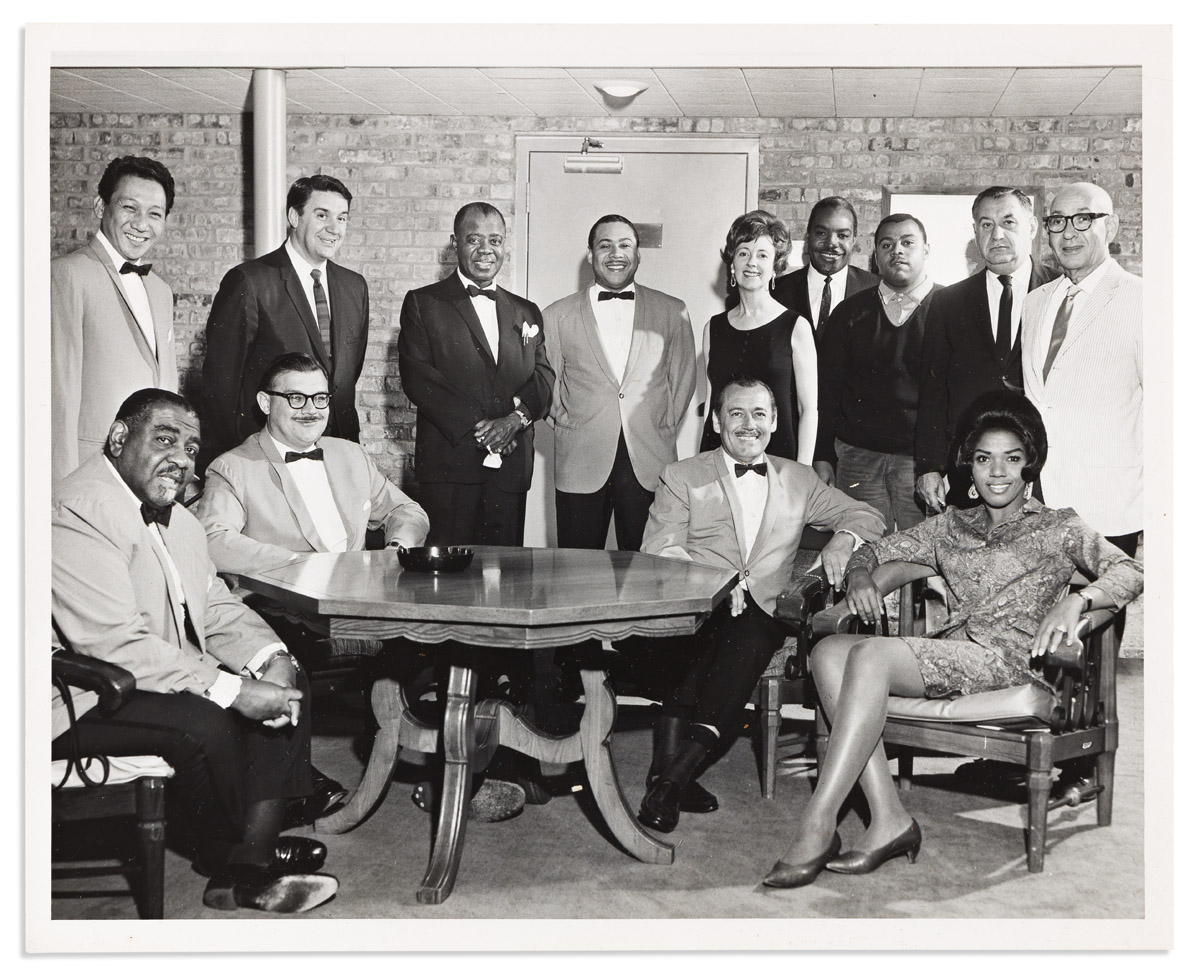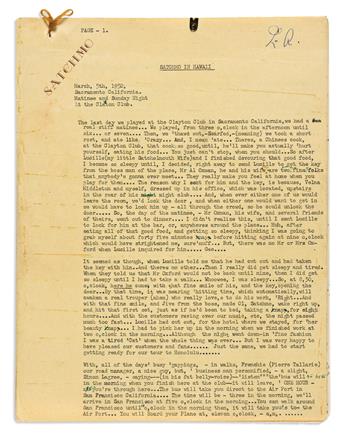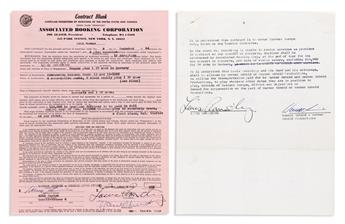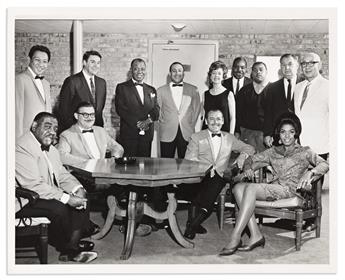Sale 2598 - Lot 261
Price Realized: $ 24,000
Price Realized: $ 30,000
?Final Price Realized includes Buyer’s Premium added to Hammer Price
Estimate: $ 6,000 - $ 9,000
(ENTERTAINMENT--MUSIC.) Substantial archive of Louis Armstrong, including memoirs, signed contract, travel itineraries, and more. Approximately 145 items (0.3 linear feet) in one box; condition generally strong. Various places, 1950-1970 and undated
Additional Details
This archive helps tell the story of the great jazz trumpeter and vocalist Louis Armstrong (1901-1971). It was collected by his longtime personal physician and close associate Dr. Alexander Schiff (1899-1990), who accompanied Armstrong on tour through most of the 1960s.
Most notable in this lot are a group of Armstrong's typescript memoirs. "Satchmo in Hawaii" is an original typescript in 22 single-spaced pages, signed by Armstrong at the end, with his initials on every page. The first 8 pages are on yellow "Satchmo" letterhead, and the remainder on mismatched plain sheets, the whole bound in one corner with a tied rubber band. It was written on 5 March 1952, and begins with a gig in Sacramento's Clayton Club [24 February 1952]. It recounts every detail of the ensuing week-long tour of Hawaii, commenting on other jazz players he hears there, every enormous meal he eats, every radio interview. His process is explained on page 16: "I sit here listening to my tape recorder, which I usually keep going constantly while I'm writing." He signs it "Am red beans and ricely yours, Louis Armstrong."
Two shorter memoirs appear to be carbon copies, and are not signed. "The Roaring Twenties, Chicago, Ill." is 9 pages, with several inked notes and corrections, covering events from his early career in 1922. "The Satchmo Story" is 10 pages, also with numerous corrections, covering his time in Chicago in 1931, ranging from his fondness for marijuana to the health problems which afflicted trombonist Jimmy Harrison. This one is accompanied by a torn and stained 10 December 1954 letter signed by Armstrong to agent Joe Glaser: "I am sending this part of the story in now as I think it is important." Finally, a pair of "Recordio-Disc" home-recorded 45-rpm phonograph records has "Armstrong's Story as read by Lucille Armstrong," recorded in Washington on 31 October 1950 and sent to agent Glaser. The memoirs appear to be unpublished, and we trace no other examples of the "Roaring Twenties."
One other item is signed by Armstrong, a contract arranged by Associated Booking Corporation for a 4-week tour in Germany and Czechoslovakia in 1965. Armstrong signed both the one-page contract and the final page of the 3-page typed rider.
Photographs include a packet of 23 snapshots from a Japanese tour, most 6 1/2 x 4 3/4 inches and most depicting Armstrong; an 8 x 10-inch shot of Armstrong and his entourage dining at the Empire Room in Chicago; 14 8 x 10-inch publicity photographs (some duplicates); and an 8 x 10 shot of Armstrong and friends at the Mr. President Hotel in Grand Rapids, MI.
A folder of correspondence and memoranda, 1951-1969 (29 items) is mostly directed to Armstrong's physician Alexander Schiff, and largely relates to Armstrong tour arrangements and medical treatment, but sometimes extends into creative territory. Highlights include a 1951 film pitch for "The Louis Armstrong Story"; 1959 cameraman's report on filming "Louis Armstrong in the Holy Land"; and letters arranging a 1960 African tour. Agent Joe Glaser, a frequent correspondent, wrote to the doctor on 2 January 1968: "See that Louis rehearses a couple of those new songs and gets ready to do them on the Hollywood Place show, because I don't want him to repeat anything." Another thick folder of tour calendars and itineraries (40 items) in a variety of formats is dated 1959-1970.
Printed ephemera includes 9 programs from Armstrong events, 1965-1970; Down Beat Magazine's "Salute to Satch" from 1965; and postcards from resort appearances (including some duplicates). More unusual is a German medical article offprint from 1961 describing dental treatment for horn players.
Provenance: collected by Dr. Alexander Schiff, and then by gift to the consignor.
Most notable in this lot are a group of Armstrong's typescript memoirs. "Satchmo in Hawaii" is an original typescript in 22 single-spaced pages, signed by Armstrong at the end, with his initials on every page. The first 8 pages are on yellow "Satchmo" letterhead, and the remainder on mismatched plain sheets, the whole bound in one corner with a tied rubber band. It was written on 5 March 1952, and begins with a gig in Sacramento's Clayton Club [24 February 1952]. It recounts every detail of the ensuing week-long tour of Hawaii, commenting on other jazz players he hears there, every enormous meal he eats, every radio interview. His process is explained on page 16: "I sit here listening to my tape recorder, which I usually keep going constantly while I'm writing." He signs it "Am red beans and ricely yours, Louis Armstrong."
Two shorter memoirs appear to be carbon copies, and are not signed. "The Roaring Twenties, Chicago, Ill." is 9 pages, with several inked notes and corrections, covering events from his early career in 1922. "The Satchmo Story" is 10 pages, also with numerous corrections, covering his time in Chicago in 1931, ranging from his fondness for marijuana to the health problems which afflicted trombonist Jimmy Harrison. This one is accompanied by a torn and stained 10 December 1954 letter signed by Armstrong to agent Joe Glaser: "I am sending this part of the story in now as I think it is important." Finally, a pair of "Recordio-Disc" home-recorded 45-rpm phonograph records has "Armstrong's Story as read by Lucille Armstrong," recorded in Washington on 31 October 1950 and sent to agent Glaser. The memoirs appear to be unpublished, and we trace no other examples of the "Roaring Twenties."
One other item is signed by Armstrong, a contract arranged by Associated Booking Corporation for a 4-week tour in Germany and Czechoslovakia in 1965. Armstrong signed both the one-page contract and the final page of the 3-page typed rider.
Photographs include a packet of 23 snapshots from a Japanese tour, most 6 1/2 x 4 3/4 inches and most depicting Armstrong; an 8 x 10-inch shot of Armstrong and his entourage dining at the Empire Room in Chicago; 14 8 x 10-inch publicity photographs (some duplicates); and an 8 x 10 shot of Armstrong and friends at the Mr. President Hotel in Grand Rapids, MI.
A folder of correspondence and memoranda, 1951-1969 (29 items) is mostly directed to Armstrong's physician Alexander Schiff, and largely relates to Armstrong tour arrangements and medical treatment, but sometimes extends into creative territory. Highlights include a 1951 film pitch for "The Louis Armstrong Story"; 1959 cameraman's report on filming "Louis Armstrong in the Holy Land"; and letters arranging a 1960 African tour. Agent Joe Glaser, a frequent correspondent, wrote to the doctor on 2 January 1968: "See that Louis rehearses a couple of those new songs and gets ready to do them on the Hollywood Place show, because I don't want him to repeat anything." Another thick folder of tour calendars and itineraries (40 items) in a variety of formats is dated 1959-1970.
Printed ephemera includes 9 programs from Armstrong events, 1965-1970; Down Beat Magazine's "Salute to Satch" from 1965; and postcards from resort appearances (including some duplicates). More unusual is a German medical article offprint from 1961 describing dental treatment for horn players.
Provenance: collected by Dr. Alexander Schiff, and then by gift to the consignor.
Exhibition Hours
Exhibition Hours
Aliquam vulputate ornare congue. Vestibulum maximus, libero in placerat faucibus, risus nisl molestie massa, ut maximus metus lectus vel lorem.



